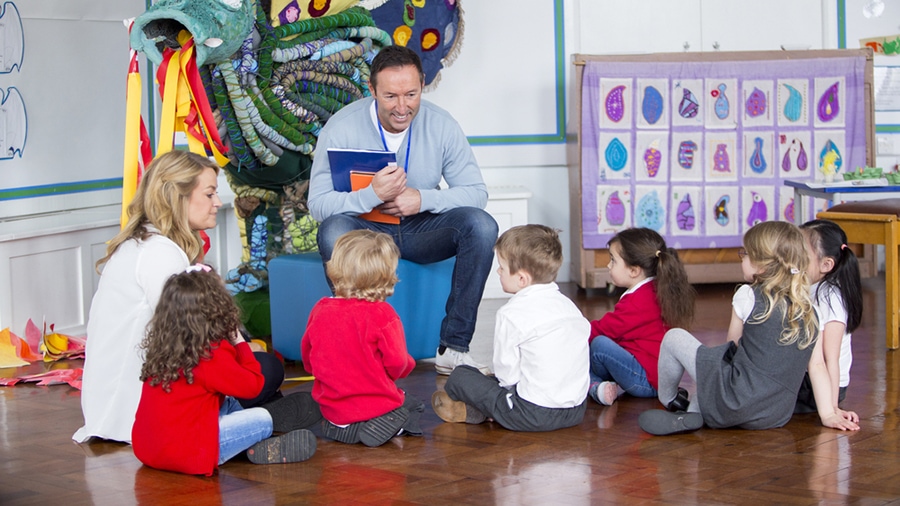How childcare workers can avoid injuries on the job
Childcare workers are trained to think ahead when it comes to the risks the infants, toddlers and preschoolers in their care might face. They follow safe sleep practices for babies, and stay up-to-date on CPR training. They keep age-inappropriate toys and choking hazards out of the hands of explorative toddlers and help adventurous preschoolers avoid major bumps and falls.
But childcare workers, even while surrounded by a culture of safety, are often at risk for injury themselves. Slips, trips and falls, along with ergonomic stressors and infection risks, can lead to acute injuries or long-term health problems.
However, by focusing on injury prevention—for both children and staff—childcare workers and their employers can avoid many of these issues. Like other workplaces, childcare settings benefit from clear safety guidelines, ergonomic equipment upgrades and training. Investing in staff safety also has an added benefit: Teachers and caretakers are role models to the children they work with. By modeling safe practices and involving kids in an age-appropriate way, childcare workers can help create a safer space for everyone.
Top risks faced by childcare workers
While a lot of care goes into setting up an early childhood classroom, there’s no getting around the presence of certain risks: an abundance of toys, muddy boots and wet raincoats, spilled sippy cups, child-sized furniture and a developing sense of personal hygiene. Then there are, of course, the kids themselves—in need of careful positioning as infants, changing table lifts as toddlers and comforting hugs as preschoolers.
For adults working in this setting, injuries can happen, sometimes as the result of an accident or because of repetitive movements. Childcare workers are most likely to be affected by:
- Slips, trips and falls
- Ergonomic strains
- Illness and pathogen exposure
Fortunately, childcare settings can also be made safer for adults. And while it sometimes requires an investment in new equipment, it often comes down to habit shifts and training.
Minimizing slip, trip and fall hazards in a childcare setting
An organized classroom can quickly become a maze of tripping hazards after a few minutes of play. Spills that go unnoticed or sit a few minutes can become risks the next time the teacher races across the room. And a lack of adult-sized stepping stools or stepladders can lead to falls from chairs or tables when a caretaker needs to reach high storage areas.
Some organizational or equipment changes to the classroom can help eliminate or minimize risks:
- Built-in storage that’s simple and kid friendly, like cubbies, low shelves and hooks, helps keep the floor clear.
- Regular cleanup routines—ones that involve the kids—help ensure the room is tidy before transitioning to the next thing.
- Out-of-reach storage and toy rotation can help minimize the amount of materials that are out at once.
- Easy-access, adult-sized stepladders eliminate the need to stand on unsteady items.
- Water absorbing, non-slip mats near sinks and cubbies help soak up spills and dripping boots or coats.
- Classroom rugs with non-slip backing make trips less likely.
- Clear markings for steps or changes in grade help avoid falls.
- Extra staff coverage during mealtimes makes it easier to clean up spills while still closely supervising children.
School or daycare directors can also update policies to require non-slip shoes for staff and make it easy for caretakers to report concerns.

Ergonomic solutions for childcare workers
With repeated movements, awkward positions and heavy lifting, childcare workers are at risk for musculoskeletal injuries (MSI). School and daycare directors should prioritize ergonomics in the classroom with training and equipment upgrades.
New caretakers should learn proper lifting techniques and child-height seating positions that minimize back strain. For example, sitting on the floor for an extended period with no support can lead to muscle strain. By leaning against a wall or pillow, or by investing in a floor chair, adults can interact with kids on their level while protecting the lower back.
Co-teachers can lessen repeated stress by rotating higher-strain jobs, like diapering or lifting kids into highchairs. Gear that allows kids to be more independent, like changing table stairs for older toddlers or stools and child seats for preschoolers using toilets, also helps cut down on heavy lifting.
Other classroom changes like vertical storage for nap mats, streamlined snack preparation areas and correctly positioned crib mattresses may also lessen back strain through less lifting, twisting and reaching. Multi-strollers or buggies also help with transporting pre-walkers.
Infection control in childcare settings
Because teachers and caretakers of young kids frequently handle waste, provide basic first aid and wipe up plenty of runny noses, childcare centers need clear rules on infection control and prevention when it comes to pathogens.
Gloves should be worn during diaper changes or first aid treatment, and staff should understand hand washing procedures and cleaning and sanitizing policies.
Call an Atlanta workers’ compensation lawyer
If you’re a childcare worker who has been hurt on the job, a workers’ comp attorney can help with your case. Contact the Law Offices of Laura Lanzisera today for a free consultation, or give us a call at 404-991-5097.

Leave a Reply
Want to join the discussion?Feel free to contribute!